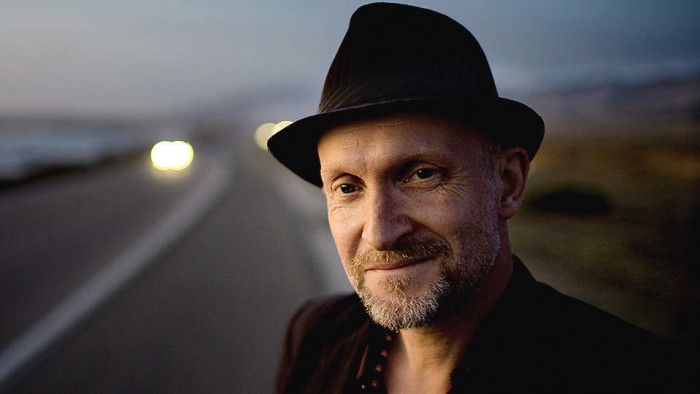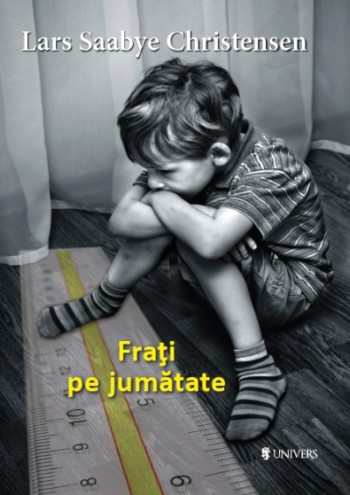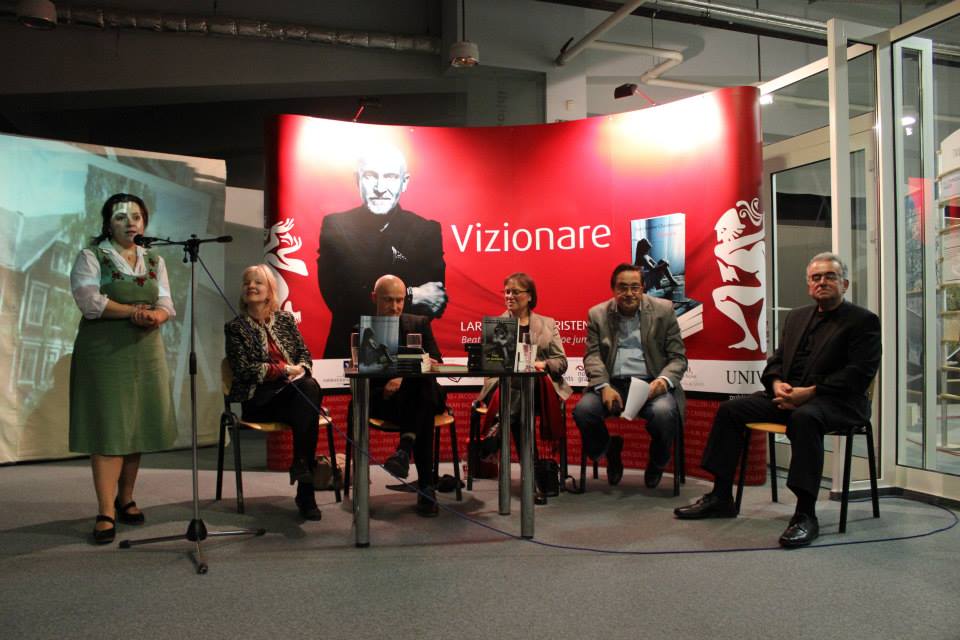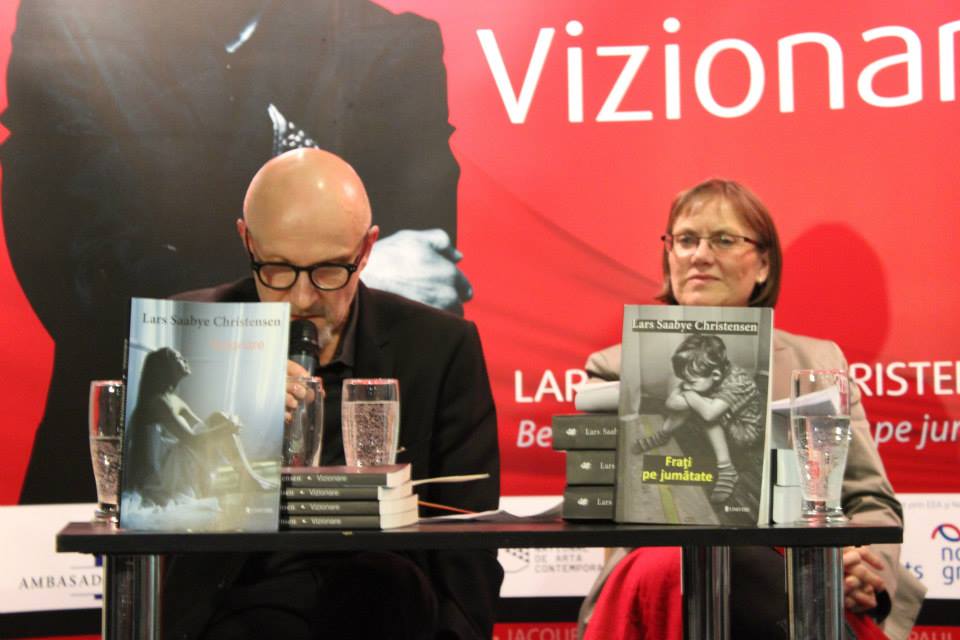
Lars Saabye Christensen is one of the most representative contemporary Norwegian writers. Even though he also wrote children’s books, scripts, plays, poetry, he is best known as a novelist. He published over twenty novels, out of which Beatles and The Half Brother were sold in over 500 000 copies together and have been translated in many languages. For The Half Brother Christensen won the The Nordic Council’s Literature Prize, the most important distinction for works of literature written in one of the languages of the Nordic countries. He is also a member of the Norwegian Academy for Language and Literature.
He was in Romania, both in Cluj-Napoca and Bucharest, between the 10th and 14th of March, at the invitation of Univers Publishing House. Then he launched his book just translated in Romanian, Visning (View).
I had the opportunity to meet the famous Norwegian author in Bucharest and we talked, for half an hour, about his literature, about the decisive moment of becoming a writer, about how it’s the literary scene nowadays in Norway, about the choice of plots, about the influence of music upon his novels, about imagination, time, silence, about how you write a good sex scene and many other things, as you’ll discover below.
I start with a slightly common question, but a natural one for the curiosity of any foreign reader. Are you in Romania for the first time? What was the first thing that drew your attention when you came here?
I was here in 1996 for the first time, when I launched my first book in Romanian, the novel called Beatles. Then I was in Bucharest and in Cluj, talking to students at the university there. So this is my second time in eighteen years.
I think that in this period Romania changed to the better. When I was here the first time I found it quite caustic and sometimes quite pooh, but now I saw immediately a progress: it’s more light, more smile. But the people are just as kind as the last time.
You wrote over twenty novels, over ten volumes of poetry, but also plays, children’s books, scripts. How is it to be known outside your country for only a small part of these, the ones that had success and were translated?
First of all, it’s a great experience for all writers to be translated and get a chance to find new readers in new contexts. But the core of my literary production is novels and poetry and I don’t think you have to read everything to know what I’m doing as a writer. So I’m pleased with the novels translated, they are my most important works.
You started at a very young age, you were 19 years old, with poetry. You continued with prose and then you alternated them. Does poetry get along with prose and scripts?
My first book was a collection of poetry and I’ve been writing poetry since then. The two lines are poetry and prose and sometimes I try to mix them, to use, for example, poetic language when I write novels and when I write poetry I try to invest in the language what I know as a story teller. For me, poetry and storytelling are two sides of the same language.
Can you tell us about the precise moment in which you said to yourself From now on, I am a writer?
Yes, I can. When I was quite young, a teenager growing up in Oslo, I was very inspired by rock and roll and I was also inspired when I was listening to the lyrics of Beatles, John Lennon, Paul McCartney. So I knew I wanted to write something myself.
And one day, I think I was fourteen years old, I walked through Oslo and I saw two clocks outside two shops and they were showing different times: one clock was showing ten minutes past twelve and the other ten past two. Suddenly, that confused me. Isn’t the time the same everywhere? So I went home and I wrote a poem about it. When I finished the poem I said to myself: OK, now you are a writer.
And I have been writing about time ever since.
How is it the literary scene in Norway right now?
The contemporary literature is very well represented. The Norwegians are reading a lot. They are especially very fond of thick novels and crime literature. I’m not, but it doesn’t matter.
The literary scene is very complex, there are a lot of different kind of novels written and especially by the young generation – I’m not belonging to the young generation anymore – and I appreciate what they are writing – in poetry, for example, there are a lot of new and exciting voices. There is also a trend, the autobiographical novels, a very challenging way of writing, even though I cannot write this kind of novels because my life is too boring for that, I have to use my imagination.
Anyway, it’s a challenging literary scene, with a lot of success abroad.
Both the critique and the public considered the novel The Half Brother your best book. If you would have to make a top three, which would be, from your point of view, your best three books?
That’s a tricky question, I could decline to answer it (he laughs).
I wrote a novel called Beatles when I was quite young, at the age of 25. That’s a very important novel for me because I couldn’t have written any of the other books if I haven’t written that first one. Afterwards, it comes The Half Brother, of course. And the third most important book of mine is my next novel.
In Romania, there are four of your novels translated: Herman, Beatles, The Half Brother and Visning (View) – the last one is the reason you are here, in Bucharest, to launch it. Which book would you recommend to someone who didn’t read your novels until now?
I would recommend Beatles, my first novel, because I think that all the roots of what I write are there. So I think that’s a good book to start with.
If we would have to drastically sum up the four books translated in Romanian, Herman is the story of a little boy who decides he wants to remain a child for the rest of his life, Beatles is the story of four young friends in a world which is constantly changing, The Half Brother is the book of Barnum and Fred, marked by the past, extended over four generations and I understand that View (Visning) dissects a couple in a contemporary context. There are very different plots. How do you choose them? From the hundreds of stories that come to your mind, how do you know which is fit for a book?
It’s not working that way. I don’t choose between a lot of stories. I have to find one story that is very important for me because afterwards I have to work with it for one, two, three or four years. So I have to find one that it would be important both for me and the reader. I know very soon if an idea or the beginning of a story is good enough to continue to write it.
Of course that, when I sit down and write, it’s a chance that I take, a challenge all the time. I think it it the most difficult thing for a writer to start, to begin a story.
In Beatles each chapter has as a title the name of a song of the famous British band. But in The Half Brother music doesn’t play such an important role, it is almost absent. However, could you make a playlist of the Beatles’ songs that would fit to the novel The Half Brother when we are reading it?
First of all, music has always been important for me as a writer, when I am listening to it I feel inspired. When I write, I also pay attention to the composition of the novel, to the harmonies and so on.
The playlist, ok, let’s see. I’d start with A day in the life, then with one of my favorites, Things we said today, and I saw her standing there.
http://youtu.be/DsgWfAilIEM
At first sight, when you make contact with The Half Brother book, you are impressed by its thickness and format. Weren’t you afraid then, in 2001, when you published it, that the twenty-first century readers won’t have patience or time to read a 700-pages book and they will get stuck at the first pages?
That’s a good question because today, as a writer, I’m fighting for my reader’s time. I don’t know why, but that’s how it is, the readers have less and less time to read. So there’s a lot of competition for the readers’ precious time. But when I’m writing a novel, I can’t think about that. If I begin thinking of pleasing my reader, the reader is not my reader anymore, but my customer. And I don’t want to write for customers. So I had to write it the way I felt it was the right one to do it.
When the book was published in Norway it attracted many readers, in spite its length. That pleased me, of course, personally. But it also made me happy for literature, in general, because I saw it was possible to write that kind of novel and, at the same time, get lot of readers. It was both important for me and for the Norwegian contemporary literature.
How long did it take to write The Half Brother and what challenges did you encounter in giving the novel such a complex shape on all levels (narrative, plot, construction of characters etc.)?
It took me several years to start it, continue it and finish it. Challenge is everyday. But the greatest challenge for a writer, from my point of view, is to keep the concentration for such a long time.
When you have a novel of such length, as is The Half Brother, you have to have a strong memory, to remember what you wrote on page 33 because there’s always a connection.
Another challenge is to create the composition that keeps all the story, voices and metaphors together and that’s when music comes into picture. The Beatles novel, for example, is inspired by pop-song and I think that The Half Brother is inspired by symphonies.
It seemed to me that silence plays an important role in The Half Brother. Did you use this trick to give an aura of mystery to such a lengthy novel or do you think that what is not said has a greater impact upon readers?
Silence is a very strong motif in The Half Brother and I think silence is very important for me as well. And in the Norwegian literary tradition silence plays a very important role, we don’t talk so much (he laughs).
As a writer, I have to work with silence too, I have to think about what is not said, told, what do I leave out, what empty spaces do I leave for the reader to fill out. That’s again a kind of working with the balance because if you say one word less, it is irritating, and if you say one word too much, you can ruin the novel, it becomes ordinary and boring. So I try very hard to work with this interaction between telling and silence.
It is rumored that some of the most difficult scenes to write are the sex-related ones. Your sex scenes are beautifully written – in The Half Brother, for example, somewhere at the beginning of the novel, Barnum as a grown-up wakes up in a hotel room and watches a porn; it is an excellent mastered sequence; as it is the rape scene. Every single word seems to be in the right place. You are far away from winning the Bad Sex in Fiction Award. How do you make it?
It’s true that it’s more difficult to write about some topics. If you write one extra word in the sex scene it becomes extremely embarrassing for everybody. You have to use very few words and you have to select them with very accurate sensibility. That’s what I’m trying to do. I have read many sex scenes in contemporary literature and I really think it’s a lot of garbage.
How do we tell “true lies”?
I never use the verb “to lie”. Imagination and fiction, those are my instruments. I have to convince my reader that this didn’t happen, but it could have happened. It is difficult for a writer to convince the reader that he has to believe in his story. You need honesty in the way you use your language and on behalf of the story you’re telling, but also honesty in your attitude towards the reader – I always think that the reader is smarter than me.
Among the contemporary authors, which ones do you read and prefer?
Now I am in a place in my life and in my literature in which I want to read the classics once again, all the great books that I read when I was eighteen, nineteen, twenty years old. That’s what I’m reading today, both Norwegian and international literature.
Main image. The other pictures are from the book launch from Bucharest, at the National Museum of Contemporary Art; alongside Lars Saabye Christensen there are Tove Bruvik Westberg, the Norwegian Ambassador in Romania, Sanda Tomescu Baciu, Dan C. Mihăilescu, Cristian Teodorescu. Via







